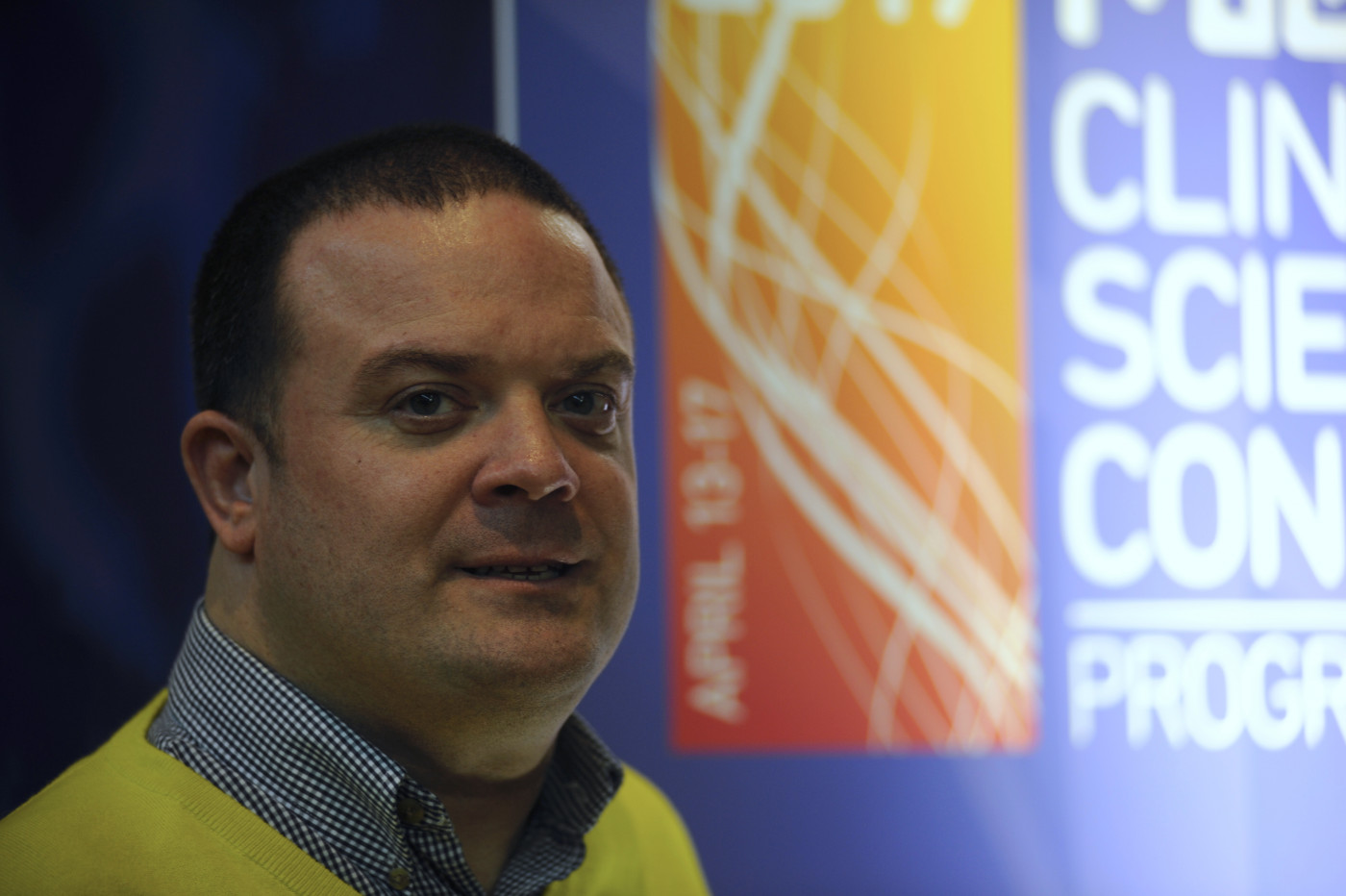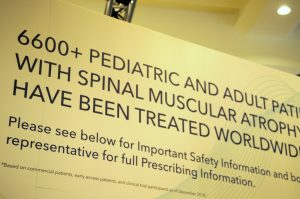Pennsylvania SMA Patient: ‘Spinraza Has Changed My Life’

Spinal muscular atrophy (SMA) patient Michael Noon of Hilltown, Pennsylvania, says the Biogen drug Spinraza improved his quality of life immediately. (Photo by Larry Luxner)
Michael Noon, 42, says the thing he hates most about spinal muscular atrophy (SMA) is having to constantly ask other people for assistance.
“I’m keenly aware of the physical help I need, and as I’ve gotten weaker over the years, that’s always been my internal struggle,” he said. “You go around this life once, and whatever your physical or emotional struggle is, you’ve got to learn to deal with it and move on. My burden is physical. Everyone sees it.”
Noon — a resident of Hilltown, Pennsylvania — said he feels bad that his parents, who are retired, cannot travel the way they had planned to do because they must care for him at home.
“I need help getting out of bed and getting dressed,” said Noon, who has SMA type 3. “Relying on others for simple things like getting a drink of water or a snack is really hard for me.”
Yet Noon’s life has improved considerably since he started taking Spinraza (nusinersen), an injectable therapy that remains the only medication approved by the U.S. Food and Drug Administration (FDA) to treat all SMA patients, regardless of age or disease type.
Noon spoke at the 2019 MDA Clinical and Scientific Conference, a mid-April gathering in Orlando, Florida, organized by the nonprofit Muscular Dystrophy Association. Spinraza’s manufacturer, Biogen, sponsored the lunch talk at which Noon shared the stage with two doctors who specialize in treating patients with SMA and other neuromuscular disorders.
Margaret Frey, MD, is the director of neuromuscular medicine at Michigan State University in East Lansing. She said the earlier an SMA patient begins treatment with Spinraza, the better.
“We should start Spinraza as soon as we can get the patient through the insurance authorization process,” Frey said. “There’s no need to wait.”
Frey said all 15 SMA patients currently in her care have managed to get insurance coverage for Spinraza.
“Fortunately, we’ve not yet been in a position where we’ve been unable to cover them,” she said. “And we have stopped the medication in just one of our patients — a 57-year-old woman who was already quite weak at baseline.”
A pricey Christmas ornament
SMA is a progressive neurodegenerative disease that affects some 9,000 Americans. Type 1 has the highest incidence (about 60% of all SMA births) but the lowest prevalence due to mortality. At present, according to Biogen, 15% of SMA patients in the United States have type 1, 48% have type 2, and 37% have type 3.
Spinraza is approved to treat all types, though it is prohibitively expensive. The therapy — which must be injected into the spine — retails for $750,000 the first year and $375,000 every year after for the duration of a patient’s life.
By comparison, the AveXis one-time gene therapy Zolgensma — approved May 24 by the FDA for children younger than 2 — will cost $2.125 million, payable in five yearly installments of $425,000.
“I’d be willing to treat any patient with Spinraza, as long as they had a function they didn’t want to lose,” Frey said. “I don’t think one patient’s ability to swallow is any less important than another patient’s ability to walk.”
Eric Monroe, an interventional radiologist at Seattle Children’s Hospital, noted that motor function declines as later-onset SMA patients age, along with muscle weakness and atrophy in the core and extremities. Scoliosis, or curvature of the spine, almost always develops as well.
Yet Spinraza can dramatically halt progression of the disease. In many cases, patients report immediate improvements after beginning the injections.
“One of my patients kept the empty glass Spinraza vial and made it into a Christmas ornament, and hung it on her tree,” Monroe told his audience. “She was in her mid-40s, and she had been waiting for that moment for her entire life.”
According to Monroe, some 2,600 patients in the United States — ranging in age from 3 days to 79 years — have received Spinraza since its approval in late 2016. Of them, more than 35% are adults, 80% are in their maintenance-dose phase, and only 5% have discontinued treatment. In addition, 95% of those who started have opted to continue.
Frustrations in the job market
Noon had long been aware of his limitations, even in childhood.
“When I went into first grade, I played T-ball for a year but wasn’t able to run as fast as the other kids. That’s when I knew there was something different,” he said. “Doctors couldn’t pinpoint what was wrong with me, but they never gave me a more specific diagnosis than muscular dystrophy.”
He added: “In high school, I could walk down the halls between classes, but never longer distances. When it was time to start looking at colleges, I wondered how I was going to navigate myself around a college campus. That’s when I started investigating wheelchairs.”
After graduating from college, Noon — by then dependent on a wheelchair — began looking for full-time employment, but his worsening disease proved to be a major obstacle.
“I was unable to walk up stairs, but I still didn’t want to disclose my disability before an interview. One day I showed up to a building that was totally inaccessible. After that, I began disclosing my SMA on the phone.”
Noon finally landed a job at a local bank, working his way up to operations manager of the bank’s mortgage call center.
It wasn’t long, however, before he had trouble moving files across his desk. Then, around his 30th birthday, he began feeling a heaviness in his upper body.
In 2008, the bank closed its call center and Noon was laid off. That turned out to be a blessing.
“Leaving the workforce gave me a lease on life,” he said. “I felt like a teenager again, going to the gym every day. But I feel disconnected with my friends because they still go to work. To this day, I feel really embarrassed that I’m still unemployed.”
8 injections and still going strong
Meanwhile, Noon spent much of his time online, searching the internet for information about his disease. When he heard about Spinraza’s pending FDA approval in late 2016, he made an appointment with his neurologist to discuss it.
“We spoke about some common side effects, such as lower respiratory infection, fever, constipation, vomiting and back pain,” he said. “I was approved for the medication, and my first injection was booked for September 2017.
“I felt different after the first day. It was a positive experience from day one,” said Noon, who recently had his eighth injection.
Since going on Spinraza, Noon says he’s been noticing small improvements in his core strength.
“I’m able to bend over to pick things up and move myself back into a seated position again,” he said. “I feel a little bit stronger in my arms, too. I’m able to eat with more ease, move my arms around in the shower, and while brushing my teeth. I also feel a little more secure standing.”
Noon added: “What gives me anxiety is when I feel stuck and can’t move. In bed, I have to lie on my side because I can’t roll over to reach the phone. Usually my parents will help me get up, and then I’ll take my shower and have breakfast.”
Noon said he was excited to hear about the FDA’s recent approval of Zolgensma — and that if the gene therapy is eventually approved for adults, he’d definitely consider taking it.
“From what I’ve been reading, the virus used to get the missing gene into your body can only be used once,” he said. “So my concern is, would there possibly be something better down the line — and if they needed to use that virus, would my body already be immune to it by taking Zolgensma?”
Many questions remain, but for now, Noon says, “I’m grateful to be able to be on Spinraza, as it has stabilized my SMA. I wish all countries around the world would make it available.”









